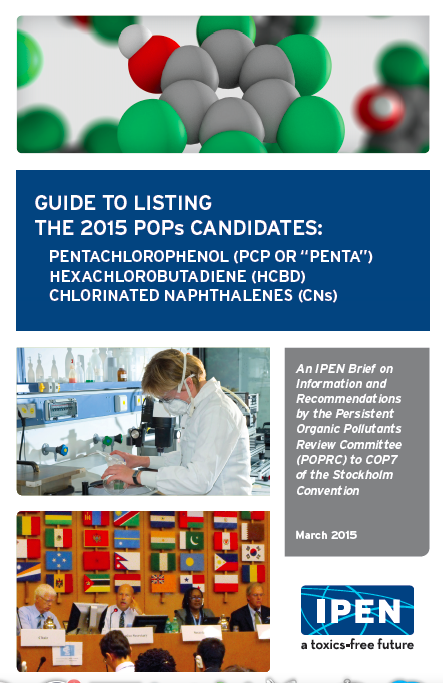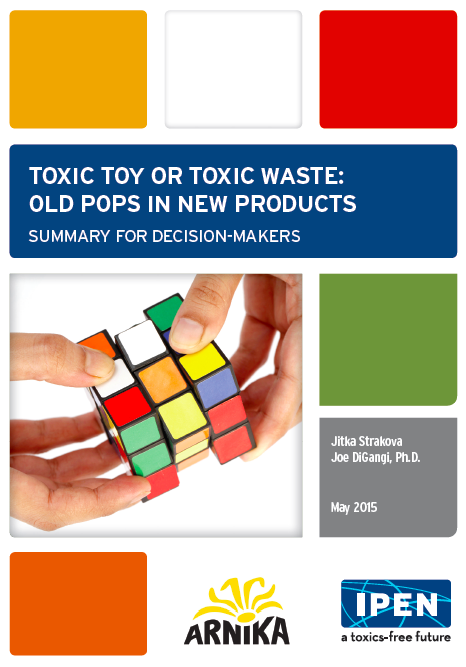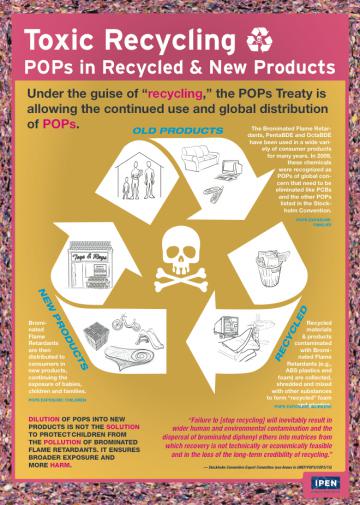Documents / Positions
IPEN Quick Views of Stockholm Convention COP7
In the run-up to the Stockholm Convention's 7th Conference of the Parties, IPEN has released its "Quick Views of Stockholm Convention COP7." This document is a summary statement of IPEN views on issues that COP7 will be called upon to address, including POPs wastes, tecnical assistance and regional centres, rules of procedure, compliance, listing of pentachlorophenol (PCP) in Annex A, listing of hexachlorobutadiene (HCBD) in Annex A and C, exemptions and acceptable purposes, evaluation of PFOS, and more.
IPEN Guide to Listing the 2015 POPs Candidates
The Stockholm Convention established a science-based process for new persistent organic pollutants (POPs) under the Stockholm Convention. The Convention recognizes that a lack of full scientific certainty should not prevent a candidate substance from proceeding in the evaluation or listing and clearly mandates Parties to decide on listing “in a precautionary manner.” This new Guide (English /русский /español / français / العربية) highlights three new candidates for listing in the Convention in 2015 - pentachlorophenol, hexachlorobutadiene, and chlorinated naphthalenes - and provides the POPs Review Committee's recommendation for which annex the POPs should be listed under in the Convention, the chemicals' uses, alternatives, adverse effects, and more.
 See the Guide to Listing the 2015 POPs Candidates here
See the Guide to Listing the 2015 POPs Candidates here
Fact sheet: Solutions for the Destruction of POPs Waste
This fact sheet provides information about four non-combustion methods for the destruction of POPs waste: gas phase chemical reduction, base catalyzed decompisition, super critical water oxidation and sodium reduction. Further, two very interesting technologies are also presented:
-
A destruction technology that operates under mild reaction conditions (room temperature and pressure); and
-
A technology for removing brominated flame retardants from waste plastics.
See the fact sheet here
Toxic Toy or Toxic Waste: Old POPs in New Products
This study, prepared by Arnika Toxics and Waste Programme, brings forward evidence about recycling of plastic parts of electronic waste contaminated by POPs-PBDEs, as well as by alternatives to PBDEs. The results raise concerns about Low POPs Content Level of PBDEs and E-waste management, including recycling materials containing flame retardants that result in further human and environmental exposure to substances listed in the Stockholm Convention for global elimination, particularly for E-waste workshop operators, recyclers and children.
Read the full report here
See a summary of the report below or here
Toxic Toy or Toxic Waste: Old POPs in New Products (summary for decision-makers)
This summary presents findings from a survey conducted by Arnika of PBDE flame retardants in Rubik’s cubes, a children’s product made of plastic. Information was sought to determine whether PBDE substances commonly found in electronic waste were present in the toys and if they exceeded proposed low POPs content limits of 50 ppm.
Read the summary here

After Incineration: The Toxic Ash Problem (2015 update)
In this report, IPEN's Dioxin, PCBs and Waste Working Group demonstrates that waste incineration residues represent a serious threat to both the local and global environment, as they contain high quantities of unintentionally produced persistent organic pollutants (U-POPs) listed under Annex C of the Stockholm Convention (dioxins, PCBs and hexachlorobenzene). See the report here
Poster: Global Fish and Community Mercury Monitoring Project
This poster highlights information found via a study conducted by IPEN and the Biodiversity Research Institute to identify global biological mercury hotspots. These hotspots are of particular concern to human populations and the ecosystems on which they depend.
Poster: A Survey of PBDEs in Recycled Carpet Padding
This poster highlights information found via a study of recycled foam carpet padding from Canada, Hungary, Kyrgyzstan, Nepal, Thailand, and USA that was screened for bromine using a handheld XRF machine, and analyzed in a laboratory for polybromodiphenyl ethers (PBDEs).
Rotterdam Convention Alliance: Position Paper on the 7th Conference of the Parties to the Rotterdam Convention
Rotterdam Convention Alliance: Frequently Asked Questions about Chrysotile and the Rotterdam Convention
Conference variant

